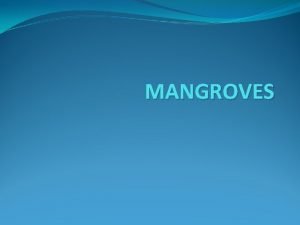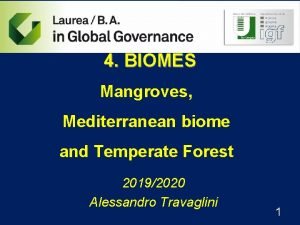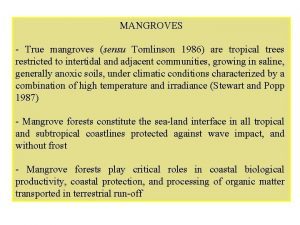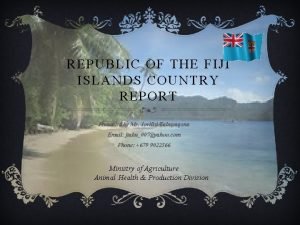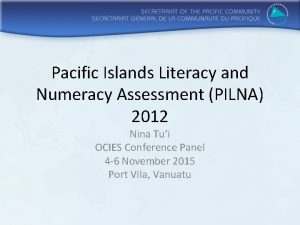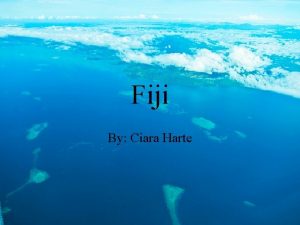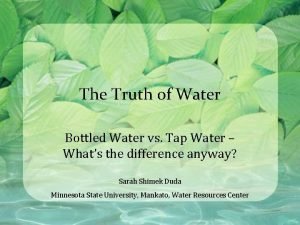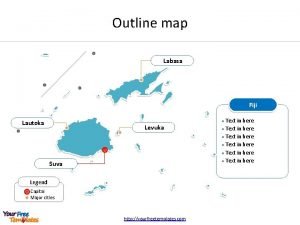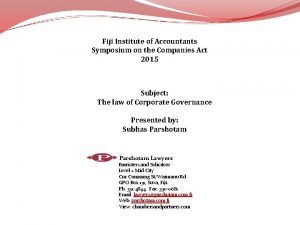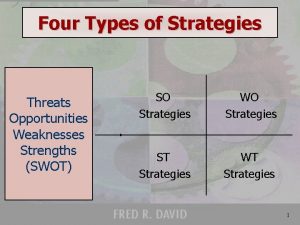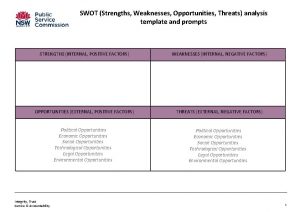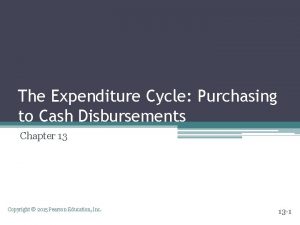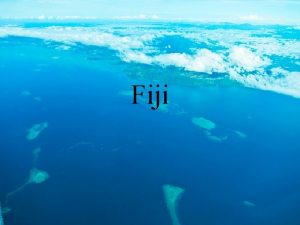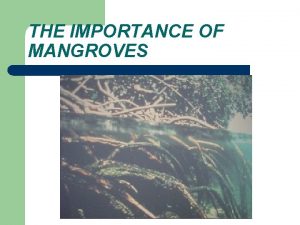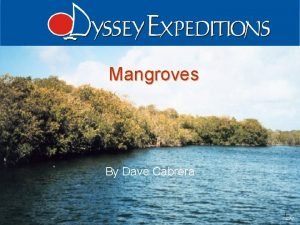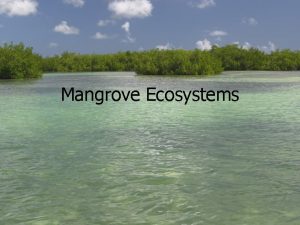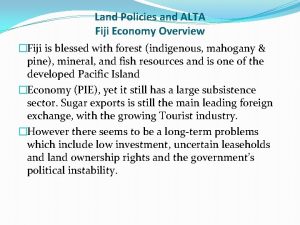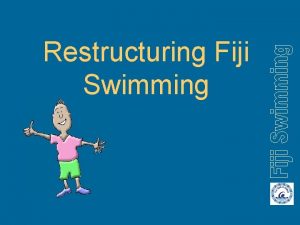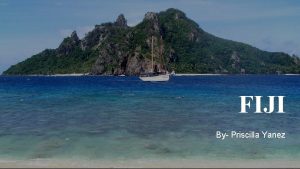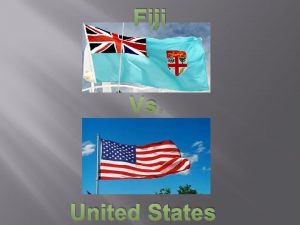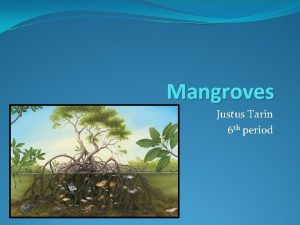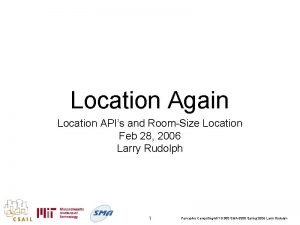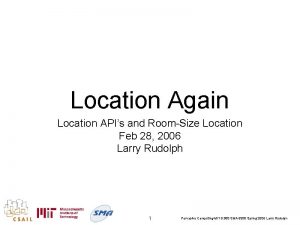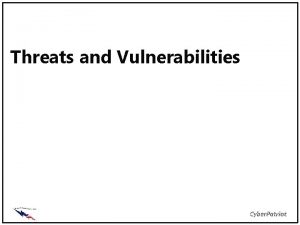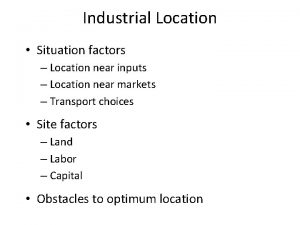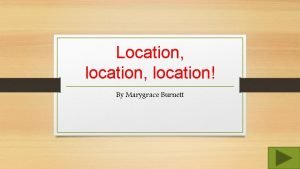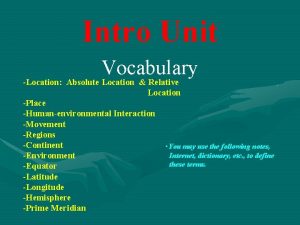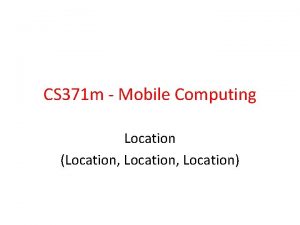Mangroves Location Importance and Threats in Fiji Viliame
































- Slides: 32

Mangroves – Location, Importance and Threats in Fiji Viliame Momoivalu ID: 2017 21260

Outline q. Introduction q. Location q. Importance q. Threats q. Strategic Action for Sustainable Management

Introduction Mangrove Mangal: a tropical shoreline community in which various species of mangrove are the dominant plant species q Halophytes , complex salt filtration system and complex root system to cope with salt water immersion and wave action. q They are adapted to the low oxygen (anoxic) conditions of waterlogged mud.

Introduction Mangrove Distribution (Source: sciencetopia. org) q 137, 800 square kilometres (53, 200 sq mi), spanning 118 countries and territories q Sub-tropic and tropical zones

Top 20 Mangrove Nation Habitat in 2014 (Source: wikipedia. org) Tree Cover in Mangrove Biome (km 2) RANK Country Name Tree Cover in Mangrove Forests ( km 2) 1 Indonesia 23, 324. 29 44, 038. 77 2 Brazil 7, 674. 94 17, 685. 60 3 Malaysia 4, 725. 84 8, 231. 09 4 Papua New Guinea 4, 172. 29 5, 677. 16 5 Australia 3, 316. 21 3, 251. 24 6 Mexico 2, 991. 83 6, 203. 92 7 Myanmar 2, 557. 45 3, 856. 09 8 Nigeria 2, 653. 99 6, 919. 28 9 Venezuela 2, 403. 83 7, 539. 12 10 Philippines 2, 064. 24 2, 089. 24 11 Thailand 1, 886. 33 4, 196. 97 12 Bangladesh 1, 772. 98 2, 314. 56 13 Colombia 1, 671. 86 6, 274. 70 14 Cuba 1, 633. 46 2, 454. 10 15 United States 1, 568. 60 1, 585. 06 16 Panama 1, 323. 94 2, 708. 21 17 Mozambique 1, 223. 67 2, 677. 27 18 Cameroon 1, 112. 76 1, 332. 16 19 Gabon 1, 082. 11 3, 882. 95 20 Ecuador 935. 74 1, 945. 27

FIJI Population 890, 057 Density 48. 7 km 2 Languages English, Fijian Independence 1970 Capital Suva Currency Fiji Dollar GDP 4, 029, 989, 729 (2014) Land Area 18, 274 km 2 Min Longitude Max Longitude 180. 000 171. 000 Min Latitude Max Latitude 20° 30’ 15° 30’ 844 islands Rainfall 106 2000 -3000 mm/6000 mm

Distribution in Fiji N

Mangrove Ecology High tide Low tide Coastal zone Red Mangrove Middle zone Black Mangrove Inland zone White Mangrove

Spotted Mangrove-Rizophora stylosa (Tiritabua) Description: • medium sized tree ranging from 8 -30 m in height. • Leaves are about 10 cm long and slightly rounded with a small spike at the tip and have a lighter green undersurface covered with brown specs. • Flowers are white and are wind or insect pollinated. • Seeds are long with a bulging cap. Flowering and Fruiting: Flowering takes place from February to April whereas fruiting takes place throughout the year. Uses: Used in building, dye production, firewood. Habitat: While it is most commonly found on beach fronts or lower tidal reaches it may also extend upstream along estuaries and rivers that remain brackish through most of the year. Distribution: Very widespread distribution ranging from India to the Pacific. Common throughout the Fiji group

Samoan Mangrove, Rhizophora samoensis (Tiri Wai) Description: • This species gets from 2 -10 m in height. • The roots are stilted which is typical of the red mangrove species. • The leaves are usually around 10 cm long although in some instances they grow longer and have blunt tips. • White petal flowers with a yellowish bud that is relatively small, i. e. about 10 mm when mature. • Seeds grow on the tree and are shed once fully developed. They are long and slim and have bumps along the sides. They are usually green with a brown tip. Flowering and Fruiting: Throughout the year. Uses: • Timber used for construction. • Medicinal purposes. • Also utilized in dye production, i. e. tapa/masi designs etc… Habitat: Usually found in proximity of rivers Distribution: Found throughout Fiji and also in Samoa, Tonga and New Caledonia.

Hybrid Mangrove, Rhizophora x selala (Selala) Description: • Grows from 4 -10 m in height. • Similar to R. stylosa and R. samoensis; i. e. stilt roots. • Leaves have a sharp tip. • Flowers are white and occasionally yellow. • Does not produce seeds or fruits Uses: no specific use recorded thus far, but frequently used for firewood. Habitat: occurs only in mangrove swamps where both R. stylosa and R. samoensis are present. Distribution: it is a locally common species known to occur only in Fiji and New Caledonia.

Large-leafed Mangrove: Bruguiera gymnorhiza (Dogo) Description: • This species of black mangrove grows from 4 -15 m in height. • Supported by knee/elbow roots which rise up around the main trunk then curve straight back into the soil. • Leaves are long, slim and hairless coming to a point without a spike. • Flowers are white before fading to a brown. • Seeds are short and fat, usually dark green or brown all over. Germinates on the tree and is shed once mature. Flowering and Fruiting: occurs throughout the year. Uses: Timber is used for building and firewood whilst the bark is used to concoct dyes and medicine. Habitat: only at sea level along mangrove swamps. Distribution: It is one of the most widely distributed trees in the tropics ranging from Africa, Southeast Asia, Australia and throughout the small and large Pacific islands including Samoa, Tonga and Fiji.

Teruntum Merah, Lumnitzera littorea (Sagali) Description: Grows as a shrub at 2 m but also known to spread out and reach a height of 9 m. Leaves are narrow at the base then extend into an oval shape reaching a length of 8 -9 cm. Flowers small (2 -3 cm) in dense bunches, bright red with five tiny petals (the stamens are much longer than the petals). The flowers are fragrant and produce lots of nectar. This species appears to be predominantly pollinated by birds, especially sunbirds and honey eaters, with bees and wasps as additional visitors. Fruits are green before turning to brown Flowering and Fruiting: occurs throughout the year Habitat: in the drier part or directly behind mangrove swamps Uses: the timber is hard and durable, and thus sought after for marine pilings as well as bridges, wharves, parts of canoes and other household items. There are reports that pier posts made of the tree were still sound after 20 50 years. When first cut it smells of roses. But large-sized timber is rare. It is also used as firewood. . Leaves said to have medicinal value. Distribution: Ranges from Asia to the Pacific through Australia

Looking-Glass Mangrove, Heritiera littoralis Kedra ivi na yalewa kalou Description: • Grows up to 8 m in height, though in some foreign countries it is noted to reach 25 m. • Leaves are a pointed oval shape that can be 25 cm long and 15 cm in breadth with silvery scales on the underside, which therefore appear green from top and white from below • Flowers are a light green in colour. • Fruits are greenish-brown with a shiny texture. There is a stiff keel/ridge along one side. Uses: The hard and strong timber is valued for masts, when it can be got straight enough. It is also used for canoes, firewood, house posts, joists, pressers, telegraph poles, wheel-hubs and boat-ribs. An extract of the seed can be used to treat diarrhoea and dysentery. Flowering and Fruiting: usually flowers through January to July and bears fruit throughout the year. Habitat: occurs in coastal forests and mangrove swamps. Distribution: this species is locally abundant. It ranges from Eastern Africa through Australia and the Pacific as far as Tonga, Cook Islands and Society Islands. It is also said to be introduced in Hawaii.

Blind-your-Eye Mangrove, Excoecaria agallocha, Milky Mangrove, Poisonfish Tree and River Poison Tree (Sinu gaga) Description: Tree that can grow up to 15 m tall. Leaves elliptic to ovate, 4 -10 cm x 1. 5 -5 cm, rounded or sub-emarginate to obtusely short acuminate at apex. The young leaves are pinkish. Old leaves turn bright red when they are about to drop off. Flower greenish, inconspicuous. Each tree bears either male or female flowers. So when they are in bloom, the trees can look Confusingly different. The flowers are wind pollinated. Uses: Latex causes intense skin irritation and reputedly may cause blindness if rubbed into eyes. Treat sores and stings from marine creatures. The plant is being tested for modern medical uses. Modern clinical trials show that the plant may have anti-HIV, anti-cancer, anti-bacterial and anti-viral properties. Habitat type: Found at or near sea level in mangrove swamps and beach thickets or along lower river courses. The tree grows further inland usually at the high water mark. It can grow in both stony and muddy ground. The tree can tolerate dry and salty conditions. It grows quickly in open areas, but can also survive in shade. Flowering and Fruiting: Flowers October and February, fruiting between January and July. The fruit capsules explode when ripe to disperse the seeds by water. The seeds have an air space within the seed coat to help them float. They don’t germinate on the parent tree. Distribution: Ranges from India through to the Pacific And in Africa.

Cannonball Mangrove, Xylocarpus granatum Puzzlenut Tree (Dabi) Description: Grows over 10 meters tall. Buttresses long and snaking laterally; bark light brown, yellowish or greenish, smooth, flaking off. The leaves are pinnate, leather-like in texture, oval and wide at the middle becoming pointed at tips. Flowers fragrant, with white petals, about 8 mm across. The fruits are round and greenish to brown in color. They consist of several segments that can be taken apart and re-assembled like a puzzle Flowering and Fruiting: Usually from September to late April Habitat: This species is found intermixed with Bruguieria or grows behind it Uses: The tree is used by the locals in boat-building, furniture wood and firewood. Bark used for tanning. Used on cloth, the bark dyes an umber colour. Root used as a remedy against cholera and dysentery in folklore. Distribution: Found from Africa and India through to the Pacific

Importance 1. Biodivesity 2. Livelihood 3. Water Quality 6. Material 4. Carbon Storage 5. Coastal Defence 7. Sustainable development


Lutjanus griseus (Gray snapper) MANGROVES AS NURSERIES Juveniles live in mangroves & move to Thalassia at night to feed Spawn on ocean side of reef Postlarva moves to Thalassia beds

Legislation q ü ü ü British Colonial Law All land below HWM is Crown Land 1933 designated as Forest Reserve (DOF) 1975 Jurisdiction of DOL Traditional land-water ownership system Fishing regulated Piecemeal legislation of British der. Forestry licence under the Forestry Act EMA 2005 Coastal wetlands are given management protection Protect environment and use resources sustainabily Environment Impact system, natural resource inventory, database and management plan, coastline zone definition excl. water & incl. land

THREATS Mangroves distribution Percentage of mangroves threaten per area

q Climate Change Impact ü Sea Level Rise ü Hurricanes & Storms ü Changes in Precipitation q Anthropogenic stress ü Pollution ü Deforestation ü Land Use Conversion ü Sedimentation

Cyclones and Storms q Nov – April (Jan – Feb) q 10 -15 cyclones/ decade q Dominant NW – SE TRACKS q ↑incidence since 1990 q Narrow zone of coastal wave q Complete defoliation over narrow areas of cyclone path q Large scale flooding q Rapid sedimentation

q Sea Level Rise ü Distinct zonation sea ward to high water mark ü Freq. of inundation and salinity exposure ü Controlled SL elevation seaward margin (stable) ü Large sedimentary shoreline with gentle gradient MSL & level of mean high water spring tide ü Disrupted by increase of 0. 3 m ü Retreat landward with rise of 1 m q Precipitation Changes ü Taller, ↑productive and diverse forest grow on coast ↑rainfall ü Drier coastline, stunted of narrow margins & interupted by salt flats ü Humid: almost cont. leached by heavy rain & fresh water is available from river discharge and groundwater outflows provide nutrient ü Arid: evaporation from inter-tidal mangroves of low tides ↑conc. of salt in some unvegetated hypersaline flats around high tide ü Flowering & propagules ↑success in ↑ rainfall

Pollution Subdivision Anthropogenic Harvesing Unplanned development activities

Elllison. J (2014), Vulnerability assessment of mangroves to CC and sea level rise impacts q Tidal range and coastal gradient control lateral extent of swamp ü Species zones q > relocation of intertidal habitats in microtidal areas rel to macrotidal areas q Habitat availability also mangrove soil formation physio-chemical properties establishment of ecosystem associates

q. Investigate components of a CC mangrove vulnerability assessments q. Develop an analysis procedure to allow managers identify specific vulnerability q. Facilitate Basic Management Plan

↓tidal range, impacts from non climate stressors, impacts of moderate seaward edge retreat Vulnerability assessment ranking of the three sites

Management Strategies to promote vertical accretion in mangroves

STRATEGIC ACTIONS FOR SUSTAINABLE MANAGEMENT q ü q ü q q ü Encourage community regulation Initiatives (Existing System - Fish Warden) Zone Mangrove Ecosystems Town Planning and Subdivision Act Develop Mangrove Management Plans Fiji MMP 2 (2013 -Draft) Reassess the Value of Mangroves Ecosystems Monitoring (Finance, Equipment, ) Improve Community Information Rehabilitate degraded mangrove systems and inshore reef areas Proper Planning and Assessment

References 1. Saenger P (1999), Sustainable management of mangroves. Southern Cross University, Australia. 2. Ellison. J C (2014), Vulnerability assessment of mangroves to climate change and sea level rise impacts. School of Land Food, University of Tasmania, Australia 3. Ellison. J C (2010)Vulnerability of Fiji mangrove and associated coral reefs to Climate Change. School of Land Food, University of Tasmania, Australia 4. Watling R(1985) Mangrove Management Plan for Fiji. Department of Lands, Fiji

THANK YOU VINAKA ARIGATO GOZAIMASU
 Introduction of mangroves
Introduction of mangroves Mangroves biomes
Mangroves biomes Tomlinson 1986
Tomlinson 1986 Private mail bag
Private mail bag Countries near fiji
Countries near fiji Pilna papers fiji
Pilna papers fiji Fiji history facts
Fiji history facts Companies act 2015 fiji
Companies act 2015 fiji Fiji water truth
Fiji water truth Tracey wong
Tracey wong /threads/ fiji
/threads/ fiji Fiji map outline
Fiji map outline Fiji fishing industry association
Fiji fishing industry association My apa fiji
My apa fiji Mahendra kumar fiji
Mahendra kumar fiji Usp moodle
Usp moodle Roles of a consumer
Roles of a consumer Ubkie
Ubkie Aon insurance fiji
Aon insurance fiji Fiji institute of accountants
Fiji institute of accountants A cross country skier moves from location a to location b
A cross country skier moves from location a to location b Regional factors for location planning
Regional factors for location planning Wireless security threats and vulnerabilities
Wireless security threats and vulnerabilities Swotwo
Swotwo Cyber security threats and countermeasures
Cyber security threats and countermeasures Malicious attacks threats and vulnerabilities
Malicious attacks threats and vulnerabilities Opportunities and threats of a bakery
Opportunities and threats of a bakery Swot analysis of a teacher
Swot analysis of a teacher Swot analysis example for teachers
Swot analysis example for teachers Challenges with power of media and information
Challenges with power of media and information Strengths weaknesses opportunities and threats template
Strengths weaknesses opportunities and threats template Virus and related threats
Virus and related threats 4 basic expenditure cycle activities
4 basic expenditure cycle activities
